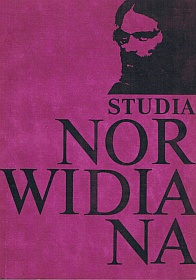Poetry in a Critical Phase. Cyprian Norwid’s Poetic Cycle Vade-mecum. (Translated from the German by Jan Gotfryd)
Abstract
The text has been conceived as a preface to the bilingual, Polish and German, edition of Norwid’s Vade-mecum (VM). Section (1), “Contemporary literature and its new attitude towards the literary past” , tries to characterize the ways in which VM might be interesting in the context of new tendencies in post-war German poetry. It deals with the problem of a delimitation of literary past and literary present. Newly present developments in literature can repress certain earlier “modern” literary phenomena into the domain of past literature, but the opposite
tendency is possible, likewise: New literary developments can, and actually do, imply an increased receptivity towards older literature, can redefine the beginning of contemporary literary tradition. Norwid’s VM (1866) is introduced as a potential “new” point of departure to a present current of poetry seeking other devices of expression and other functions than the poetry of the “modernite” of Mallarme, Rimbaud, Valery, Gottfried Benn etc.
This proposal of a German reception of Norwid’s VM is followed by an outline of selected phases and aspects of Norwid’s posthumous reception in Poland and the reception of his VM. Before the two world wars, VM existed only as a number of poems from Norwid’s mature phase as a poet, as a phase of his poetical biography and as a certain myth and legend. Only with the post-war editions of the whole collection in its original arrangement (as far as it has been preserved) has VM gained the status of a literary fact as a poetic cycle. (Section (2), “Some aspects of Norwid’s reception”).
Section (3), “Structure and themes of a ‘poetry in a critical phase’” , deals with the double sense of Norwid’s own formula of poetry being “in a critical moment” . Firstly, the work refers to a critical moment of the history of poetry. “Poetry, as an energy, survives any time conditions, but it does not necessarily survive them as art” (Norwid). The semantic construction of VM is based not on a new and static conception of poetry opposed to older, romantic and post-romantic ones, but rather on a specific relation to the unended, on-going process of the history of poetry. To use common semiotic terminology, VM is an index sign and an icon sign of this process. Being an index sign of it, it is itself subject to historical change, to the passing by of historical time. But being an icon sign of the process, it likewise gains a level exterior to or above history. Hence an orientation or set (Einstellung) of its linguistic means on contemporary actuality (“time conditions”) as well as on unresolvable ambiguity. Hence the construction of the cycle’s lyrical subject as a weak “invalid of intention” as well as a prophet of the future of poetry. Hence, finally, the conflict of centrifugal and centripetal tendencies in the composition of the cycle, the conflict of a “fortuitous” arbitrariness in the arrangement of the poems with clear generic qualities in the sense of a real poetic cycle.
As an index and an icon of the history of poetry, VM is full of allusive hints evoking “all” stages of Western poetic and artistic tradition, as well as contemporary Polish and European poetry. There are allusions to a future of poetry, too, but to a lesser degree than is frequently supposed. Its future aspect lies mainly in its being conceived as an icon of the on-going literary and poetic process.
But secondly, VM is “in a critical moment” in one more sense. It is itself a criticism of the poetry and the conditions of its time in their stylistic, moral, social and political dimensions. In the concluding Section (4), an attempt is made to situate VM within literary history. VM is definitely not romantic poetry, even if we bear in mind the differences of Polish romanticism from English or German romanticism. Neither is VM realistic poetry, if there is any such thing as realistic poetry. But apparently, VM belongs to the period dominated by literary realism, more precisely to the oppositional and minority currents within the realistic period. This does not mean that its literary intentions have to be thoroughly understood as a critical answer to dominant realism. Much more evident is its polemical attitude towards Polish post-romantic opposition to literary as well as moral, social and political realism, without resulting in a clear plea for the latter.
Copyright (c) 1985-1986 Studia Norwidiana

This work is licensed under a Creative Commons Attribution-NonCommercial-NoDerivatives 4.0 International License.





